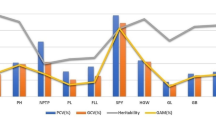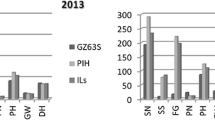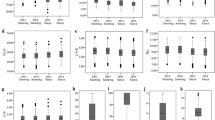Abstract
Wide-compatibility varieties (WCVs) are a special class of rice germplasm that is able to produce fertile hybrids when crossed to both indica and japonica rice varieties. WCVs may differ greatly in their spectrum and level of compatibility. The objective of this study was to determine the genetic basis of wide-compatibility conferred by ‘Dular’, a landrace variety from India that has demonstrated a high level of wide-compatibility in previous studies with a broad range of indica and japonica varieties. A three-way cross (‘Balilla/Dular//Nanjing 11’) was made and the resulting F1 population evaluated in the field for spikelet fertility. A total of 235 plants from this population was assayed individually for restriction fragment length polymorphisms (RFLPs) at 159 marker loci covering the entire rice genome at regular intervals. Quantitative trait locus (QTL) analysis identified 5 loci, located on chromosomes 1, 3, 5, 6 and 8, as having significant effects on hybrid fertility, which jointly explained 55.5% of the fertility variation in this population. The QTL on chromosome 5 ( f5) showed the largest effect on hybrid fertility, followed by those on chromosomes 6 ( f6), 3 ( f3) and 1 ( f1), with the one on chromosome 8 ( f8) having the smallest effect. Genotypes each composed of an allele from ‘Dular’ and an allele from ‘Nanjing 11’ at four ( f3, f5, f6 and f8) of the five QTLs contributed to the increase of fertility in the population. In contrast, the genotype composed of alleles from ‘Balilla’ and ‘Nanjing 11’ at the fifth locus ( f1) was in the direction of increasing fertility. Analysis of variance using marker genotypes at the five QTLs as the groups detected two interactions involving four of the five loci, a 2-locus interaction between f5 and f8 and a 3-locus interaction among f3, f5 and f6. The level of hybrid fertility is the result of complex interactions among these loci. The implication of the present findings in the utilization of the wide-compatibility of ‘Dular’ in rice breeding programs is also discussed.
Similar content being viewed by others
Author information
Authors and Affiliations
Additional information
Received: 21 October 1997 / Accepted: 30 December 1997
Rights and permissions
About this article
Cite this article
Wang, J., Liu, K., Xu, C. et al. The high level of wide-compatibility of variety ‘Dular’ has a complex genetic basis. Theor Appl Genet 97, 407–412 (1998). https://doi.org/10.1007/s001220050910
Issue Date:
DOI: https://doi.org/10.1007/s001220050910




